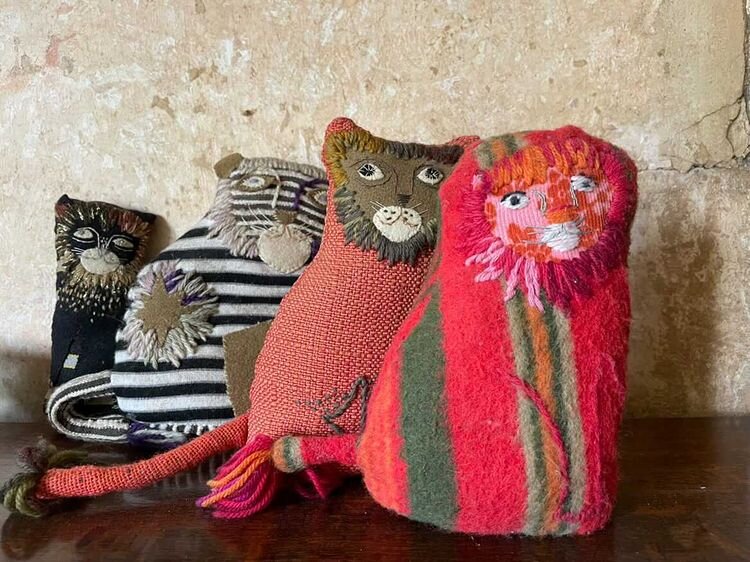Matthew Rice’s Pocket Treasure
2 September 2021
Artist, designer and writer Matthew Rice tells us about a work of art with particular meaning to him - the first instalment of a new series looking at different people’s ‘pocket treasures’.
Joe Lloyd
Joe Lloyd is a journalist who writes about architecture and visual art for The Culture Trip, Elephant, and The Economist's 1843 magazine, among others.
4 fabric lions made by Mary Fedden (1915-2012), for Matthew Rice.
Image courtesy of Matthew Rice.
Several objects sit on artist, designer and writer Matthew Rice’s dressing table. There is a piece of wood from a vegetable box, bought in a market in Venice’s Rialto: the word “Canarin” is spelt out in black lettering. There is an aborigine throwing spear, brought back from Australia by Rice’s mother, a bit of wood shaped by the Caribbean Sea, and a “very white” rock that Rice combed from a beach in North Uist. And at the back sits a pride of four fabric lions, arranged diagonally.
The lions were made by Mary Fedden (1915 — 2012), a prolific, much-admired decorative painter active from the mid-20th century to the turn of the 21st. The first one — which Rice ascribes as “the quiet, rusty one with the brown face” — was given to Rice as a child. “It’s obviously the nicest.” The other three were gifts from Fedden after the births of Rice’s own children. “They were wonderfully lavish gifts at the time,” he explains, “because they must have taken ages to do. They would certainly have taken the whole evening, when you could have done a great painting.”
Fedden and her husband, Surrealist poet and painter Julian Trevelyan, were among Rice’s childhood neighbours. “They lived in a rather wonderful old wharf on Chiswick Mall,“ Rice recounts, “where they were great entertainers, and very nice. Mary was a wonderful figure, with great, heavy burnt orange kaftans, surrounded by long-haired Siamese cats.” Felines of all shapes and sizes were a common subject in Fedden’s work. “When you went into their house,” recalls Rice, “there was a huge Elizabeth Frink lion looking at you with massive bollocks.”
Each fabric lion shares a similar form, though they are different in colour and fabric. Rice’s is made of canvas. Another, with exuberant red, green and yellow pelt, is clothed in felt, while Rice believes its black and white striped brethren is made from a jersey. “She was a very strong draughtswoman,” says Rice, “her particular hand is expressed as clearly in wool and stitching as it is in gouache and paintbrush. She’s basically painting on them with wool or cotton or felt — and that’s such a nice idea.”
A fabric lion made by Mary Fedden (1915-2012), for Matthew Rice.
Image courtesy of Matthew Rice.
Rice’s first lion was a premonition of a life full of collecting. “I started buying things at school,” he explains, “where I should have had Bob Dylan or the girl with the tennis balls and the bottom, I was busy buying leather bindings and old bits of twaddle. I think I have had an antiquarian bent for all my grown-up life.” He has steadily acquired objects and artworks since. Today, his Cotswolds home is awash with pottery and paintings. “There's a woman,” says Rice of “organising consultant” Marie Kondo, “whose great thing is making you empty your house. I can't think of anything worse — I'd hate her to come for the weekend with her bin-liners.”
Other keepsakes include a ceramic pot inscribed with a brief encomium to drinking, smoking and friendship, and a decoy duck bought in Nebraska during a trip across the US. “Travelling across America and back on the aeroplane with three decoy ducks,” says Rice “was curious company to keep.” Some items interest Rice because of their novel origins. In Britain, the ducks are a sought-after decorative item; in the US at the time they cost $5. “I thought that was a rather exciting idea,” he explains, “that something could have such a different currency in a different place.”
It also important for him that they carry a personal resonance. “Objects can be very totemic,” he says, “and very emotionally significant, and they can embody or enshrine certain events or people or ideas for you. And I think those are all very powerful ways of enriching or thickening the soup of one's life.” The handmade lions, each made to mark a moment and an individual, are the apogee of such enhancement, providing a link back to Fedden’s riverside home. “They’re lasted very well,” says Rice, “and they’ve been very well-looked after. I see them when I wake up every day. And I like to think about her: she was a nice figure, they were both very nice figures, of my childhood.”






